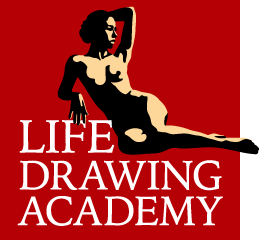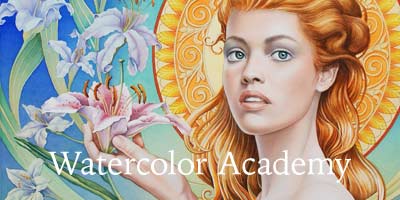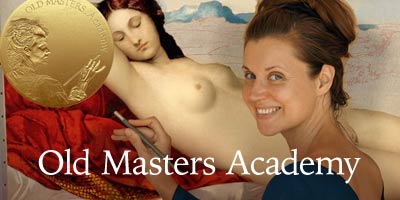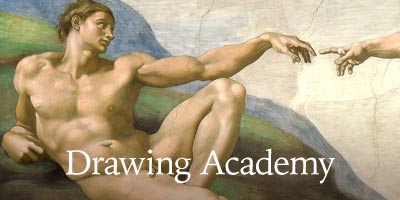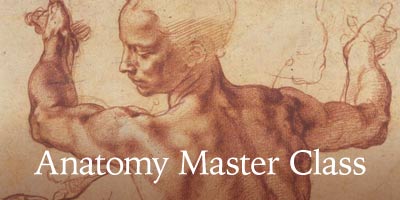Video by Vladimir London
Enroll in the Life Drawing Academy now!
Encaustic Portrait by Vladimir London
In this video, I will show you how to create a portrait composition in an ancient and noble medium, encaustic. This artwork will be created on 100% cotton, 300 gsm paper stretched on a wooden panel.
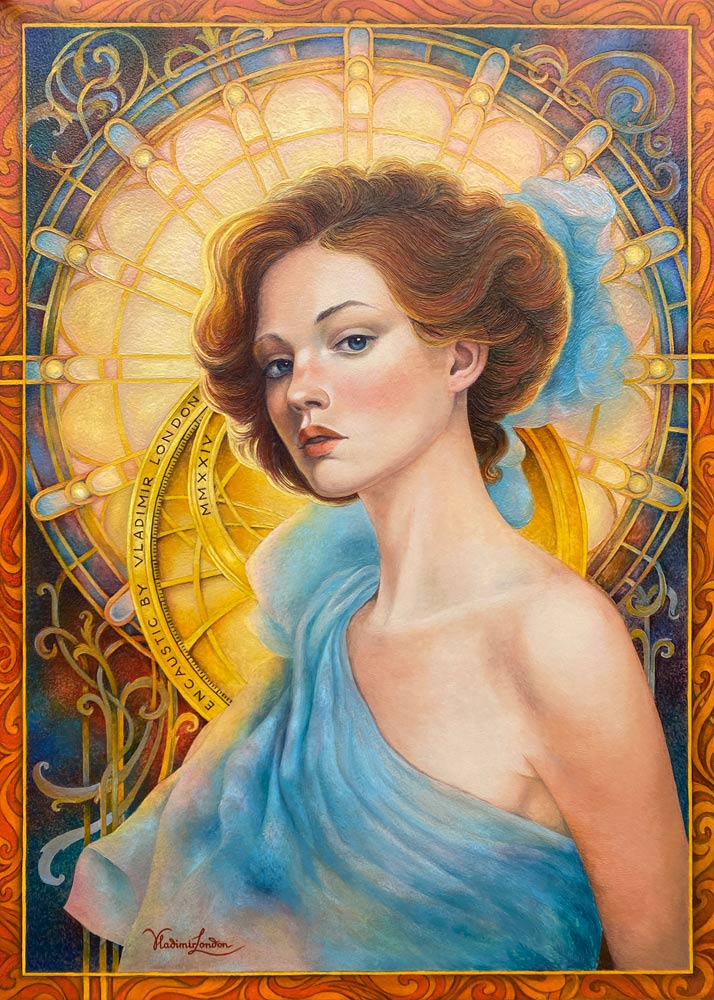
The composition design will be done on a cartoon. A cartoon is used to transfer the drawing on tracing paper. This paper is attached with masking tape to the panel at one side. Such attachment allows you to lift this paper from time to time to check the transferred image. Every line will be carefully outlined once again to leave graphite marks on the board. Encaustic paints are transparent. That is why designing a composition directly on the board is not the best way to preserve the white ground. It is better to transfer the design from a cartoon, avoiding erasing and redrawing. This is a rather mechanical task, but good preparation is needed for good results. I like drawing and painting portraits. How to draw portraits is one of the main topics in the Life Drawing Academy course, where I teach students from all over the World figurative and constructive drawing.
Here's the transferred image. It's time to do underpainting in watercolor. To begin with, I will moisten the whole sheet with clean water using a 2-inch flat brush. When the paper surface absorbs water and becomes satin, which is moist, but not highly reflective, I could use a round natural Kolinsky brush from Escoda to make wet-on-wet washes in watercolor. For this purpose, I premixed several colors from yellow to blue, including orange, red and green. I will do a variegated wash on the wet surface, applying various colors to take off the whiteness of paper. The board is tilted at about 15 degrees, so paints flow and intermix with each other, creating soft transitions between different colors. For the purpose of this exercise, it doesn't really matter which colors are used. All I want at this step is chromatic underpainting that will make the encaustic process easier and more colorful. Also, as you can see, I do not pay attention to the design outlines. The choice of colors does not depend on this drawing. However, I make sure that colder and darker colors are placed in the periphery, and closer to the center, they become lighter and warmer. When the paint comes closer to the girl's face, I leave it white, but cover the hairstyle. Also, it is a good idea to moisten paper from time to time, so no hard edges would form by accidental drying. A good variegated wash in watercolor creates very soft and diffused transitions between various colors without the back-run effects, when the paint runs between areas with different wetness.
I teach how to paint in watercolor at Watercolor Academy. There are five different methods and nine techniques of professional watercolor painting that are fully covered there. The Watercolor Academy comes with two courses - Online and Correspondence. In the Online Course, you will have a lifetime access to 80 video lessons. And in the Correspondence Course, you will get unlimited personal tutoring that comes with 100 practical tasks. We guarantee that by the end of the Correspondence Course you will reach the advanced level of watercolor painting skills. How to paint portraits in watercolor is fully covered in this course, and by doing multiple assignments with full explanation and under personal guidance, you will develop professional portrait painting abilities.
When the paper surface is dry, I will use another technique, wet on dry, to paint over this underpainting. This time, I will pay attention to the design outlines. The girl's portrait will also be painted on the dry surface. The purpose of this watercolor underpainting is only to suggest main colors and tonal values. It is not about making a fully finished watercolor. The colors should be lighter than the finished artwork will be. This underpainting will be overpainted in hot encaustic, which will complete this artwork. For encaustic, a light polychrome underpainting always works better than an underpainting done in darker tones or some monochrome color. Any portrait takes shape as soon as I paint the eyes. It is already a recognisable portrait although the skin is still white.
Here is the underpainting in watercolor. Apart from the facial features and a few details, it is almost abstract and very light. All I will add a few brushstrokes to suggest the hairstyle to complete this preparatory step of watercolor underpainting. By the way, if you want to learn how to draw portraits, check out my video: 51 Portrait Drawing Rules.
Here's the completed underpainting. The next step is to cover it with a melted beeswax medium. This is a special medium done to my recipe, which includes naturally bleached beeswax, colophony resin, linseed oil and some other ingredients important for its properties. I apply this medium with a natural hog bristle brush. To keep it liquid, the medium is heated with a hot air gun. I will work out this encaustic medium till the surface absorbs it. Such treatment seals the surface and makes it water resistant. The surface will become completely waterproof after I paint over this layer with encaustic paints. Using bleached beeswax at this step is essential to keep the white areas light. This varnishing does not change colors nor darkens the tonal values. Because this medium does not contain water, it does not dilute the watercolor paint medium, which contains water-soluble gum arabic. Resins of the encaustic medium melt together with gum arabic and permanently seal the pigments on the 100% cotton support. Such treatment with beeswax is called ganosis.
Here's the waxed artwork. It is now ready for encaustic painting. My range of encaustic paints contains almost 300 colors. More than half of them are warm and designed for portraiture. Other colors are for backgrounds and draperies. Every color block is numbered to keep the cross-reference between the transparency chart and encaustic paints. The reason why I need so many different shades and tints of colors is because I do not use a palette for encaustic paints. Colors are not mixed as I paint, but taken as needed. I prepare all encaustic paints myself.
Here's a very special DIY Vladimir London Hot Encaustic Brush™. I can control its heating temperature with one degree precision. This is the 6th generation of encaustic brushes I designed. It makes the encaustic process rather simple. All I do is take the needed color block, melt a small piece of encaustic paint with the hot brush and apply it in the support. Such a brush eliminates the need in a palette. Paints are applied directly from the paint block. Because there are so many blocks, I can get any color I want without premixing it on a palette. This saves time and paints. There is no wastage of paints because every color block is used to the last bit.
Vladimir London's Hot Encaustic Brush™ can be heated from 50 to 500 degrees celsius with a one-degree increment. This gives tremendous flexibility in encaustic painting because every medium and every paint requires its own melting temperature. The brush is small and light. It is easy to use and comes with a wide range of settings. It remembers all presets, recognises when in use and idle, and its tip is heated in a few seconds. I tend to use small-size brushes to achieve greater precision. However, the range of brushes includes various sizes - from one millimeter round brush to one inch flat brush. This covers all the needs in encaustic easel painting. The breakthrough in figurative encaustic painting is only possible when using the right tools and materials. That is why I invested considerable efforts in inventing very special encaustic painting tools. Apart from Vladimir London Encaustic Bristle Brush™, which has metal bristle as the tip, I also designed:
- Vladimir London Cauterium™
- Vladimir London Encaustic Felt Pen™
- Vladimir London Encaustic Cartridge Brush™
- and Vladimir London Encaustic Ballpoint Pen™
All these tools are unique and fully described in my Book on Encaustic, which will be announced in a separate video. I wrote this book to tell my story about the encaustic medium, paints, tools and techniques, and hope that it will be very helpful to those who are interested in this medium. All these hot painting tools use the same heating pen, but different working tips. I spent several years designing and improving these brushes and pens.
I love encaustic painting. It is a truly noble medium that withstood the test of time. I know that my encaustic artworks could last for hundreds of years without fading and disintegrating because the beeswax medium can last for millenia without changing its properties. No other paint would perform as well. I have to say that the painting process requires a deep understanding of this medium. It is not fast nor easy. My Mission as the encaustic artist is to revive this ancient medium and develop the recipes and painting techniques that would allow to fully express creative tasks an artist has in mind. To this day, the challenges of hot beeswax painting limit fine artists in numerous ways. There are many questions yet to be solved, including what the Punic Wax is, how to obtain beeswax paints that would last for centuries, and how to apply such paints in a way that gives total control over the painting process. I want to put my input into this topic and bring back the challenging and beautiful art of encaustic to its former glory. To fulfil this Mission, I share my know-how of making art in encaustic.
For many years, I was testing various encaustic materials, creating my own binders and wax paints, developing methods and techniques of hot beeswax painting. My knowledge of this medium comes not only from my own experience, but also from scientific research, old texts, visiting museums around the world to see the art of ancient Greek, Roman and Egyptian painters who intimately knew the encaustic medium.
I tend to create small-to-medium size easel paintings in encaustic, which follow the traditions of Fayum portraits. Such artworks are done in hot beeswax on wooden panels. I prepare encaustic binders and paints according to my recipes and use DIY hot brushes and cauterium to melt and apply encaustic paints on specially prepared grounds with polychromatic underpainting. The surface of paintings bears the marks of brushstrokes, which can be applied in impasto or thin and transparent glazing layers. The transparency of encaustic paints creates wonderful atmospheric effects and optical mixing of colors.
To see my other artworks in encaustic, visit my website: VladimirLondon.com/encaustic.
To learn good drawing techniques, enroll in the Life Drawing Academy course:
Online Course
A self-study, self-paced course for you to learn fundamental methods of classical drawing and improve life drawing skills by watching video lessons and doing assignments
- Unlimited access to 52 life drawing video lessons
- Lifetime membership without deadlines
- Unlimited support from the Academy tutors
- Constructive critique of your artworks
- Member access to the Academy's Art community
- Place in the Academy's Students Gallery
- Exclusive members-only newsletter and bonuses
- Life Drawing Academy Diploma of Excellence in your name
One-time payment - Lifetime membership
$297 USD
Personal Tutoring Online + Online Course
The ultimate choice if you who would like to receive personal, one-to-one tutoring from the Academy teachers, which is custom-tailored to your skills and needs
- Everything in Online Course, plus:
- Dedicated team of art tutors
- Assessment of your current level of drawing skills
- Personalized curriculum tailored to your skills and goals
- Up to 100 drawing tasks with by-task assessment
- Unlimited one-to-one personal coaching with detailed per-task instructions and feedback
- Artwork critiques and results-oriented guidance
One-time payment - Lifetime membership
$997 USD
